2006 GMC SIERRA wheel
[x] Cancel search: wheelPage 365 of 600

{CAUTION:
Things you put inside your vehicle can strike
and injure people in a sudden stop or turn, or
in a crash.
Put things in the cargo area of your
vehicle. Try to spread the weight evenly.
Never stack heavier things, like suitcases,
inside the vehicle so that some of them
are above the tops of the seats.
Do not leave an unsecured child restraint
in your vehicle.
When you carry something inside the
vehicle, secure it whenever you can.
Do not leave a seat folded down unless
you need to.
There is also important loading information for off-road
driving in this manual. See “Loading Your Vehicle
for Off-Road Driving“ underOff-Road Driving on
page 4-16.
Two-Tiered Loading
By positioning four 2 inches (5 cm) by 6 inches (15 cm)
wooden planks across the width of the pickup box,
you can create an upper load platform. The planks
must be inserted in the pickup box depressions.
The length of the planks must allow for at least a
3/4 inch (2 cm) bearing surface on each end of
the plank.
When using this upper load platform, be sure the load is
securely tied down to prevent it from shifting. The load’s
center of gravity should be positioned in a zone over the
rear axle. The zone is located in the area between the
front of each wheel well and the rear of each wheel well.
The center of gravity height must not extend above the
top of the pickup box �areboard.
Any load that extends beyond the vehicle’s taillamp
area must be properly marked according to local laws
and regulations.
Remember not to exceed the Gross Axle Weight
Rating (GAWR) of the front or rear axle.
4-53
Page 368 of 600
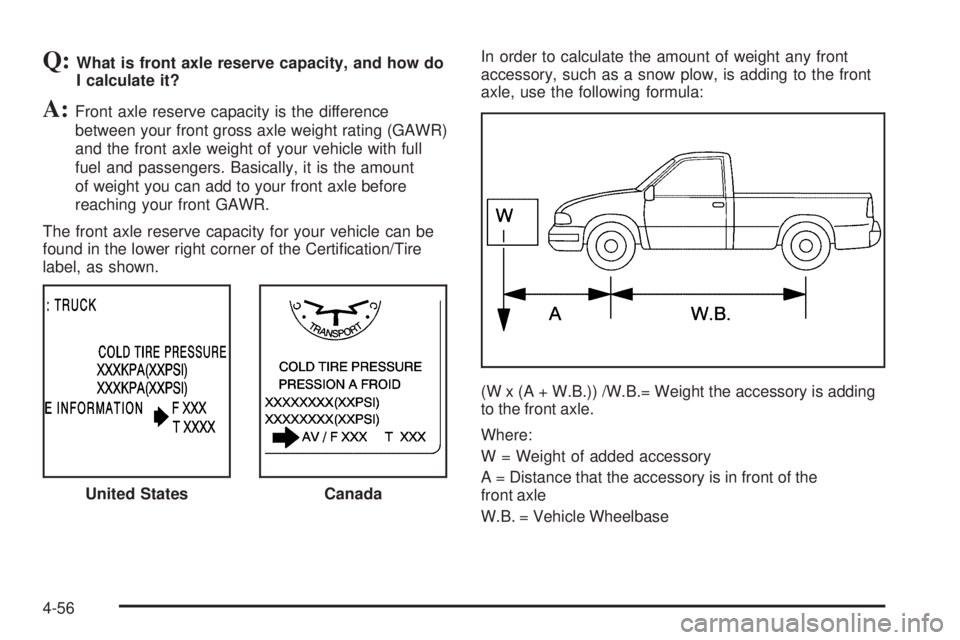
Q:What is front axle reserve capacity, and how do
I calculate it?
A:Front axle reserve capacity is the difference
between your front gross axle weight rating (GAWR)
and the front axle weight of your vehicle with full
fuel and passengers. Basically, it is the amount
of weight you can add to your front axle before
reaching your front GAWR.
The front axle reserve capacity for your vehicle can be
found in the lower right corner of the Certi�cation/Tire
label, as shown.In order to calculate the amount of weight any front
accessory, such as a snow plow, is adding to the front
axle, use the following formula:
(W x (A + W.B.)) /W.B.= Weight the accessory is adding
to the front axle.
Where:
W = Weight of added accessory
A = Distance that the accessory is in front of the
front axle
W.B. = Vehicle Wheelbase United States
Canada
4-56
Page 369 of 600

For example, adding a 700 lb (318 kg) snow plow
actually adds more than 700 lbs (318 kg) to the front
axle. Using the formula, if the snow plow is 4 ft (122 cm)
in front of the front axle and the wheel base is
10 ft (305 cm), then:
W = 700 lb (318 kg)
A = 4 ft (122 cm)
W.B. = 10 ft (305 cm)
(W x (A + W.B.))/W.B. = (700 x (4 + 10))/10 = 980 lbs
(445 kg)
So, if your truck’s front axle reserve capacity is more
than 980 lbs (445 kg), you could add the snow plow
without exceeding the front GAWR.
Q:What if I want to add heavier equipment to my
vehicle?
A:You can add heavier equipment on the front of the
vehicle if you compensate for it by carrying fewer
passengers, less cargo, or by positioning cargo
towards the rear. This has the effect of reducing
the load on the front. However, the front GAWR,
rear GAWR and the gross vehicle weight
rating (GVWR) must never be exceeded.
{CAUTION:
On some vehicles equipped with certain front
mounted equipment, such as a snow plow, it
may be possible to load the front axle to the
front GAWR but not have enough weight on the
rear axle to have proper braking performance.
If your brakes can not work properly, you could
have a crash. To help your brakes work properly
when a snow plow is installed, always follow
the snow plow manufacturer or installer’s
recommendation for rear ballast to ensure a
proper front and rear weight distribution ratio,
even though the actual front weight may be
less than the front GAWR, and the total vehicle
weight is less than the GVWR. Maintaining a
proper front and rear weight distribution ratio
is necessary to provide proper braking
performance.
4-57
Page 372 of 600
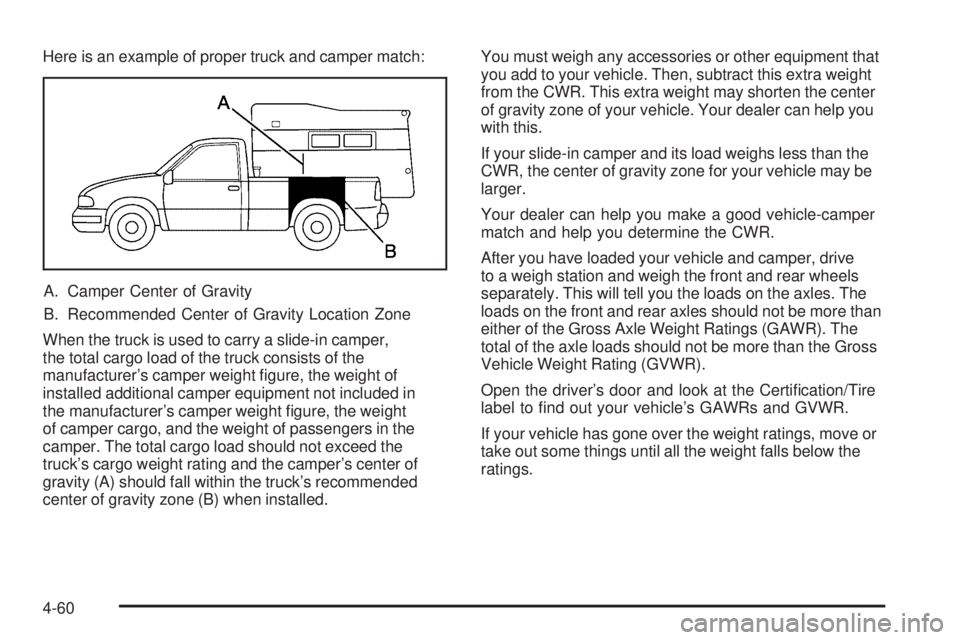
Here is an example of proper truck and camper match:
A. Camper Center of Gravity
B. Recommended Center of Gravity Location Zone
When the truck is used to carry a slide-in camper,
the total cargo load of the truck consists of the
manufacturer’s camper weight �gure, the weight of
installed additional camper equipment not included in
the manufacturer’s camper weight �gure, the weight
of camper cargo, and the weight of passengers in the
camper. The total cargo load should not exceed the
truck’s cargo weight rating and the camper’s center of
gravity (A) should fall within the truck’s recommended
center of gravity zone (B) when installed.You must weigh any accessories or other equipment that
you add to your vehicle. Then, subtract this extra weight
from the CWR. This extra weight may shorten the center
of gravity zone of your vehicle. Your dealer can help you
with this.
If your slide-in camper and its load weighs less than the
CWR, the center of gravity zone for your vehicle may be
larger.
Your dealer can help you make a good vehicle-camper
match and help you determine the CWR.
After you have loaded your vehicle and camper, drive
to a weigh station and weigh the front and rear wheels
separately. This will tell you the loads on the axles. The
loads on the front and rear axles should not be more than
either of the Gross Axle Weight Ratings (GAWR). The
total of the axle loads should not be more than the Gross
Vehicle Weight Rating (GVWR).
Open the driver’s door and look at the Certi�cation/Tire
label to �nd out your vehicle’s GAWRs and GVWR.
If your vehicle has gone over the weight ratings, move or
take out some things until all the weight falls below the
ratings.
4-60
Page 373 of 600
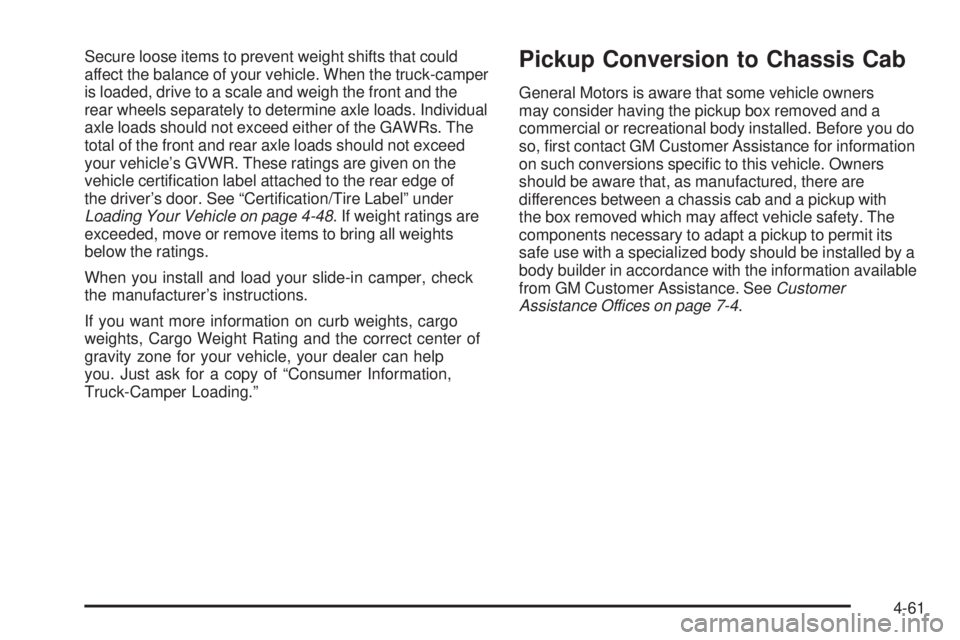
Secure loose items to prevent weight shifts that could
affect the balance of your vehicle. When the truck-camper
is loaded, drive to a scale and weigh the front and the
rear wheels separately to determine axle loads. Individual
axle loads should not exceed either of the GAWRs. The
total of the front and rear axle loads should not exceed
your vehicle’s GVWR. These ratings are given on the
vehicle certi�cation label attached to the rear edge of
the driver’s door. See “Certi�cation/Tire Label” under
Loading Your Vehicle on page 4-48. If weight ratings are
exceeded, move or remove items to bring all weights
below the ratings.
When you install and load your slide-in camper, check
the manufacturer’s instructions.
If you want more information on curb weights, cargo
weights, Cargo Weight Rating and the correct center of
gravity zone for your vehicle, your dealer can help
you. Just ask for a copy of “Consumer Information,
Truck-Camper Loading.”Pickup Conversion to Chassis Cab
General Motors is aware that some vehicle owners
may consider having the pickup box removed and a
commercial or recreational body installed. Before you do
so, �rst contact GM Customer Assistance for information
on such conversions speci�c to this vehicle. Owners
should be aware that, as manufactured, there are
differences between a chassis cab and a pickup with
the box removed which may affect vehicle safety. The
components necessary to adapt a pickup to permit its
safe use with a specialized body should be installed by a
body builder in accordance with the information available
from GM Customer Assistance. SeeCustomer
Assistance Offices on page 7-4.
4-61
Page 374 of 600
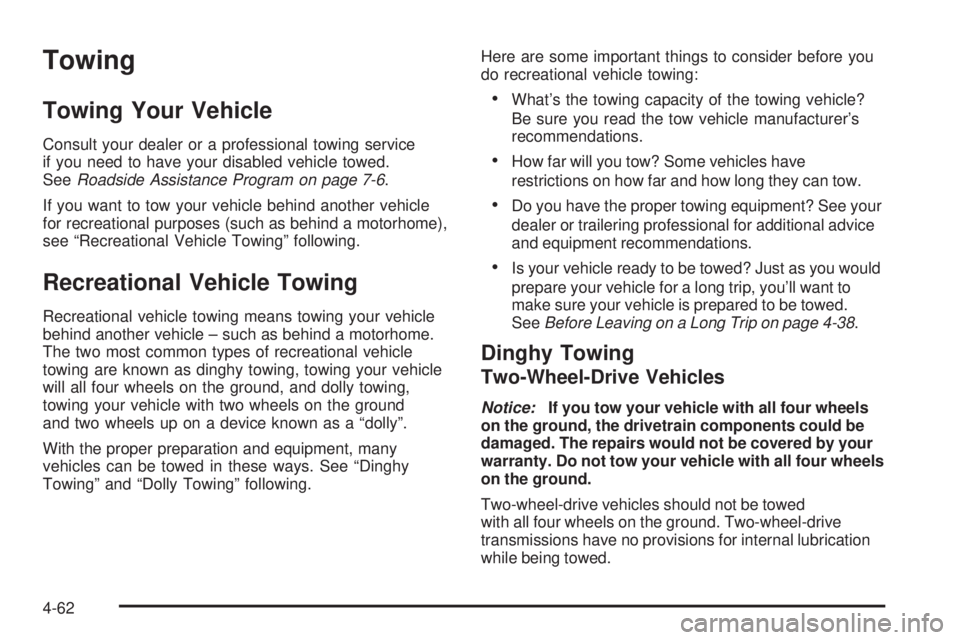
Towing
Towing Your Vehicle
Consult your dealer or a professional towing service
if you need to have your disabled vehicle towed.
SeeRoadside Assistance Program on page 7-6.
If you want to tow your vehicle behind another vehicle
for recreational purposes (such as behind a motorhome),
see “Recreational Vehicle Towing” following.
Recreational Vehicle Towing
Recreational vehicle towing means towing your vehicle
behind another vehicle – such as behind a motorhome.
The two most common types of recreational vehicle
towing are known as dinghy towing, towing your vehicle
will all four wheels on the ground, and dolly towing,
towing your vehicle with two wheels on the ground
and two wheels up on a device known as a “dolly”.
With the proper preparation and equipment, many
vehicles can be towed in these ways. See “Dinghy
Towing” and “Dolly Towing” following.Here are some important things to consider before you
do recreational vehicle towing:
What’s the towing capacity of the towing vehicle?
Be sure you read the tow vehicle manufacturer’s
recommendations.
How far will you tow? Some vehicles have
restrictions on how far and how long they can tow.
Do you have the proper towing equipment? See your
dealer or trailering professional for additional advice
and equipment recommendations.
Is your vehicle ready to be towed? Just as you would
prepare your vehicle for a long trip, you’ll want to
make sure your vehicle is prepared to be towed.
SeeBefore Leaving on a Long Trip on page 4-38.
Dinghy Towing
Two-Wheel-Drive Vehicles
Notice:If you tow your vehicle with all four wheels
on the ground, the drivetrain components could be
damaged. The repairs would not be covered by your
warranty. Do not tow your vehicle with all four wheels
on the ground.
Two-wheel-drive vehicles should not be towed
with all four wheels on the ground. Two-wheel-drive
transmissions have no provisions for internal lubrication
while being towed.
4-62
Page 375 of 600
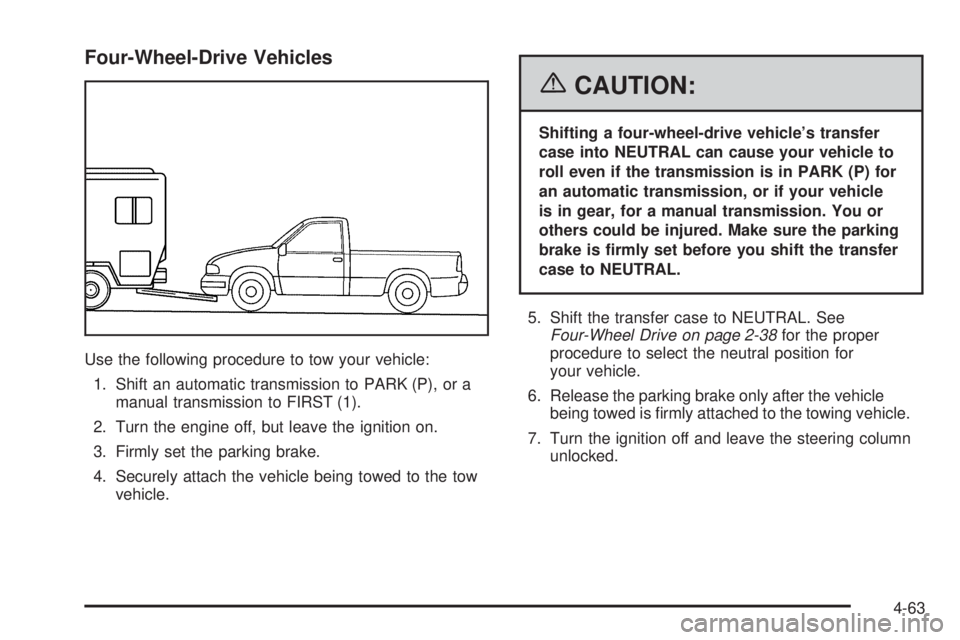
Four-Wheel-Drive Vehicles
Use the following procedure to tow your vehicle:
1. Shift an automatic transmission to PARK (P), or a
manual transmission to FIRST (1).
2. Turn the engine off, but leave the ignition on.
3. Firmly set the parking brake.
4. Securely attach the vehicle being towed to the tow
vehicle.
{CAUTION:
Shifting a four-wheel-drive vehicle’s transfer
case into NEUTRAL can cause your vehicle to
roll even if the transmission is in PARK (P) for
an automatic transmission, or if your vehicle
is in gear, for a manual transmission. You or
others could be injured. Make sure the parking
brake is �rmly set before you shift the transfer
case to NEUTRAL.
5. Shift the transfer case to NEUTRAL. See
Four-Wheel Drive on page 2-38for the proper
procedure to select the neutral position for
your vehicle.
6. Release the parking brake only after the vehicle
being towed is �rmly attached to the towing vehicle.
7. Turn the ignition off and leave the steering column
unlocked.
4-63
Page 376 of 600
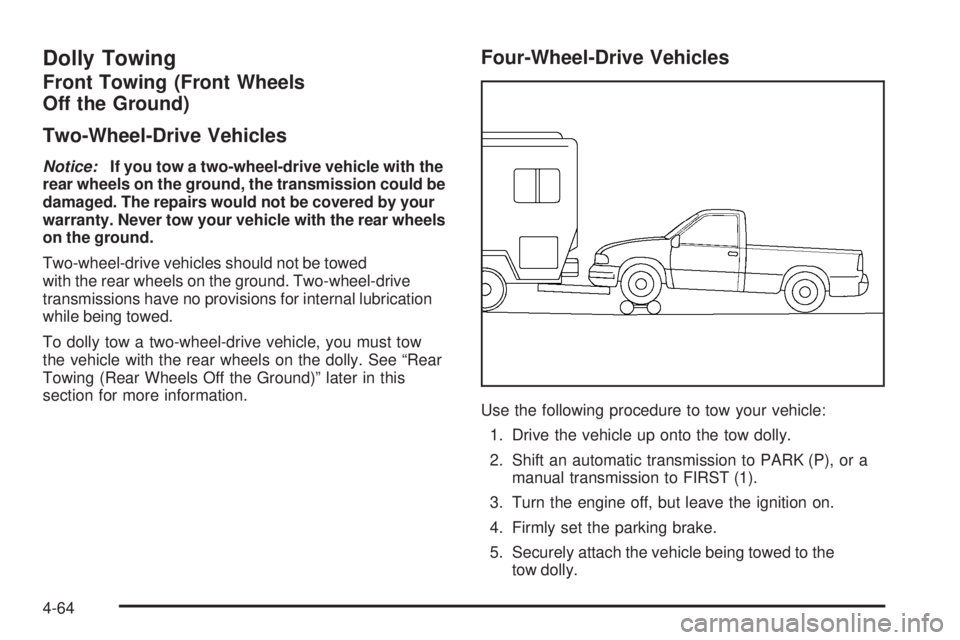
Dolly Towing
Front Towing (Front Wheels
Off the Ground)
Two-Wheel-Drive Vehicles
Notice:If you tow a two-wheel-drive vehicle with the
rear wheels on the ground, the transmission could be
damaged. The repairs would not be covered by your
warranty. Never tow your vehicle with the rear wheels
on the ground.
Two-wheel-drive vehicles should not be towed
with the rear wheels on the ground. Two-wheel-drive
transmissions have no provisions for internal lubrication
while being towed.
To dolly tow a two-wheel-drive vehicle, you must tow
the vehicle with the rear wheels on the dolly. See “Rear
Towing (Rear Wheels Off the Ground)” later in this
section for more information.
Four-Wheel-Drive Vehicles
Use the following procedure to tow your vehicle:
1. Drive the vehicle up onto the tow dolly.
2. Shift an automatic transmission to PARK (P), or a
manual transmission to FIRST (1).
3. Turn the engine off, but leave the ignition on.
4. Firmly set the parking brake.
5. Securely attach the vehicle being towed to the
tow dolly.
4-64